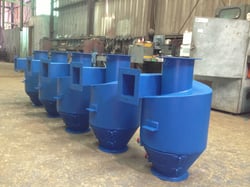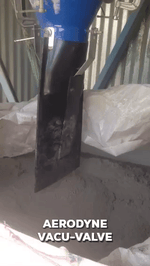
- Use pulse-on-demand controller for baghouse and cartridge collectors
Pulse-on-demand controllers allow you to clean your filter less often. Less pulses helps you save compressed air and reduces wear and tear on the filters. Cutting down on compressed air means less electricity is required in the compressors and less wear and tear on the filter means they last longer. - Install a cyclone pre-filter
 A cyclone pre-filter will help remove dust before it gets to your filters. This means that the dust loading on the filters will decrease, which helps extend their life by requiring less cleaning and plugging them up less. The cyclone can also allow you to recycle the material without contamination and possibly increase the total removal efficiency of the system.
A cyclone pre-filter will help remove dust before it gets to your filters. This means that the dust loading on the filters will decrease, which helps extend their life by requiring less cleaning and plugging them up less. The cyclone can also allow you to recycle the material without contamination and possibly increase the total removal efficiency of the system. - Monitor airflow in the dust collection system
Dust collection systems are designed to capture dust and they should be operating at design specifications. By monitoring the airflow, you are confirming that the unit is operating correctly. If the airflow is off from its design condition, then you will not be capturing the material that it was designed to capture. Measuring the airflow is similar to measuring the temperature in an oven. Without measuring it, you won’t know if you are at the correct performance and the end result may be off. -
Install Aerodyne Vacu-Valve (if appropriate)
 All dust collectors require airlocks. The standard airlock in the business is a rotary valve. Rotary valves require a motor powered by electricity. An Aerodyne Vacu-Valve has no moving parts so it just uses the vacuum already in the system to provide the airlock and gravity to pull the material through. The valve is limited in that the material can’t bridge and it can’t be explosive.
All dust collectors require airlocks. The standard airlock in the business is a rotary valve. Rotary valves require a motor powered by electricity. An Aerodyne Vacu-Valve has no moving parts so it just uses the vacuum already in the system to provide the airlock and gravity to pull the material through. The valve is limited in that the material can’t bridge and it can’t be explosive. - Clean and reuse filters
The normal procedure when replacing filters is to tear them out and throw them out when they are plugged. However, if you are monitoring the system closely you can schedule them to be removed and cleaned before they plug up and not require a new set each maintenance period. Ideally, it would be to have one full set as a spare so the crew can remove the dirty ones and install clean ones at the same time. You will then have time to clean the dirty filters and replace any that are damaged or beyond cleaning while you are operating.
